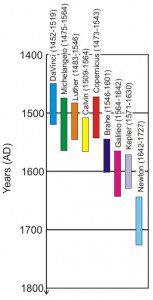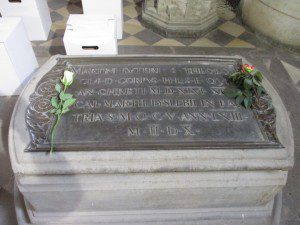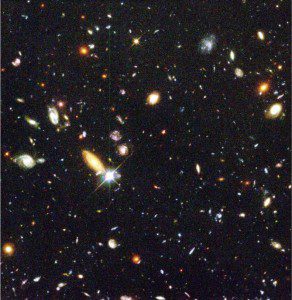 The next chapter of Kyle Greenwood’s new book Scripture and Cosmology: Reading the Bible Between the Ancient World and Modern Science looks at Christian responses to the Copernican revolution. Most of us today see no theological problem with the idea that the earth both orbits the sun and spins on its axis. Copernicus, Kepler, Galileo, and finally Newton put together a convincing argument, beginning with observation and mathematics and ultimately the theory of gravity and mechanics whereby the less massive objects orbit the more massive objects (more accurately a system of objects revolves around its center of mass).
The next chapter of Kyle Greenwood’s new book Scripture and Cosmology: Reading the Bible Between the Ancient World and Modern Science looks at Christian responses to the Copernican revolution. Most of us today see no theological problem with the idea that the earth both orbits the sun and spins on its axis. Copernicus, Kepler, Galileo, and finally Newton put together a convincing argument, beginning with observation and mathematics and ultimately the theory of gravity and mechanics whereby the less massive objects orbit the more massive objects (more accurately a system of objects revolves around its center of mass).
As time has passed our human view of cosmology has become more sophisticated, moving from (2) an empirical understanding of flat earth with a roof overhead to (2) a spherical earth with heavens revolving around, to (3) a heliocentric model with the earth, planets and stars orbiting the sun, and now (4) a centerless model, that is an infinite expanding universe having no definable center. The last stretches one’s ability to comprehend. Physicists tell us that the universe has been infinite since the Big Bang – there is no center out of which every thing emerges. Rather, the whole itself is expanding. The Old Testament presents a flat earth view (Creation Beyond Genesis), consistent with the time and culture (A Three-Tiered Universe). The early and medieval church generally accepted a spherical earth although it did lead to interpretative challenges (A Spherical Earth … Oh No!). Heliocentrism posed yet another and in some ways more significant challenge.
 Greenwood presents a good overview of the historical development and Christian responses from Copernicus (1473-1543) to Newton (1643-1727). Copernicus was approximately contemporary with Luther, Calvin, and the Protestant Revolution. Some of his ideas were known to the reformers. Georg Rheticus from the University of Wittenburg was with Copernicus from 1539-1541 and facilitated the publication of Copernicus’s “On the Revolutions of the Heavenly Spheres.” Copernicus was wary of public, and especially church, response to his theory and published his most significant work only at the end of his life. We take his insights for granted today:
Greenwood presents a good overview of the historical development and Christian responses from Copernicus (1473-1543) to Newton (1643-1727). Copernicus was approximately contemporary with Luther, Calvin, and the Protestant Revolution. Some of his ideas were known to the reformers. Georg Rheticus from the University of Wittenburg was with Copernicus from 1539-1541 and facilitated the publication of Copernicus’s “On the Revolutions of the Heavenly Spheres.” Copernicus was wary of public, and especially church, response to his theory and published his most significant work only at the end of his life. We take his insights for granted today:
In chapters ten and eleven of Revolutions, Copernicus articulates his innovative model of heavenly movements. Rather than heavenly spheres rotating around the earth, Copernicus demonstrates that a “threefold movement of the Earth” accounts for all of the celestial observations. The three movements are (1) daily rotation of the earth on its axis, (2) annual orbit of the earth around the sun and (3) seasonal shift in the tilt of the earth on its axis. (p. 163)
Copernicus’s model was good, but not perfect. In particular it did not entirely explain the motion of Mars and Venus. Kepler’s elliptical orbits provided the needed correction. The observations of Brahe and Galileo along with the mathematical prowess of Kepler put the nail in the coffin of an earth centered universe (although the idea yet took awhile to die).
Luther and Philip Melanchthon (the “intellectual leader of the Lutheran reformation”) were not enamored of Copernicus’s theory, but it is not at all clear how far their opposition extended. The only quote from Luther is of dubious authenticity, and he died shortly after On the Revolutions was published. Evidence that Calvin wasn’t convinced, and that his initial response wasn’t favorable, is found in a sermon he preached on 1 Cor. 10-11. Greenwood quotes the relevant section obtained from Robert White’s article Calvin and Copernicus (Calvin Theological Journal 15, 234, 1980):
We will see some who are so deranged, not only in religion but who in all things reveal their monstrous nature, that they will say that the sun does not move, and that it is the earth which shifts and turns. When we see such minds we must indeed confess that the devil possess them, and that God sets them up as mirrors, in order to keep us in his fear. …
Calvin is not making a cosmological argument here, but he is clearly engaging the concept of Copernican cosmology as a perverse idea, one that contradicts nature. (p. 174)
 Greenwood points out that it is not particularly surprising that Luther and Calvin were skeptical. A solar system was a brand new theory in their time. Galileo didn’t immediately accept Copernicus either, but was led to acceptance through his own study of the heavens and the tides. The Roman Catholic church opposed the Copernican theory, or at least required that it be presented as hypothetical rather than scientific. The story of Galileo is well known, but, as many historians have pointed out, aggravated by Galileo’s lack of tact and apparent ridicule of his former friend, now Pope Urban VIII.
Greenwood points out that it is not particularly surprising that Luther and Calvin were skeptical. A solar system was a brand new theory in their time. Galileo didn’t immediately accept Copernicus either, but was led to acceptance through his own study of the heavens and the tides. The Roman Catholic church opposed the Copernican theory, or at least required that it be presented as hypothetical rather than scientific. The story of Galileo is well known, but, as many historians have pointed out, aggravated by Galileo’s lack of tact and apparent ridicule of his former friend, now Pope Urban VIII.
The objections of the Lutherans hung on the authority of scripture. The objections of Calvin and other reformers hung importantly on the sovereignty of God as well as the authority of scripture. The Catholic church (and likely both Calvin and Luther as well) did not see the matter as proven and thus the idea of a heliocentric universe should be held loosely if at all. Cardinal Bellarmine, the future Pope Urban VIII, writing on Copernicus’s On the Revolutions, noted “if there were real proof that the sun is the center of the universe … then we should have to proceed with great circumspection in explaining passages of Scripture which appear to teach the contrary.” (p. 178) There were Scriptural problems to be addressed, but as the matter was yet unproven it was premature to worry about it.
In England there was more disagreement over Copernicus with some supporters and some vocal opposition as well. The opposition, Alexander Ross the most vocal, felt that accommodating Copernican theory undermined the authority of Scripture. “For Ross, standing against Copernicanism carried the same theological import as the early church’s stand against the heretical movements of Gnosticism, Manichaeism, and Valentinianism.” (p. 181)
Although the tide was turning, it was only with Newton in the late 17th century that Copernicus finally prevailed. A single set of testable laws could be used to explain all known celestial phenomena. Everything, that is, until our measurements became better and Einstein’s theory of general relativity was required to explain the discrepancies.
 Aristotle’s theory of a spherical earth surrounded by heavenly spheres was more accurate than the flat earth view that preceded it. Copernicus’s heliocentric view was more accurate than Aristotle’s. Now our understanding has advanced even further. We are on one planet orbiting one star in one spiral galaxy of an enormous expanding universe This story of refinement and advancement is the nature of science. The impressive Hubble Space Telescope deep field image of distant galaxies shown to the right covers an area something like 0ne percent of one millionth of the sky.
Aristotle’s theory of a spherical earth surrounded by heavenly spheres was more accurate than the flat earth view that preceded it. Copernicus’s heliocentric view was more accurate than Aristotle’s. Now our understanding has advanced even further. We are on one planet orbiting one star in one spiral galaxy of an enormous expanding universe This story of refinement and advancement is the nature of science. The impressive Hubble Space Telescope deep field image of distant galaxies shown to the right covers an area something like 0ne percent of one millionth of the sky.
The final section of Greenwood’s book will turn to Scripture and science and the implications for us today. We will look at this in the next post on his book.
How does the response to Copernicus resemble the arguments today on science and the authority of scripture?
What would seem to be the appropriate approach?
How much evidence is required before we should go back and reconsider our interpretation of the message of scripture?
If you wish to contact me directly you may do so at rjs4mail [at] att.net.
If interested you can subscribe to a full text feed of my posts at Musings on Science and Theology.















